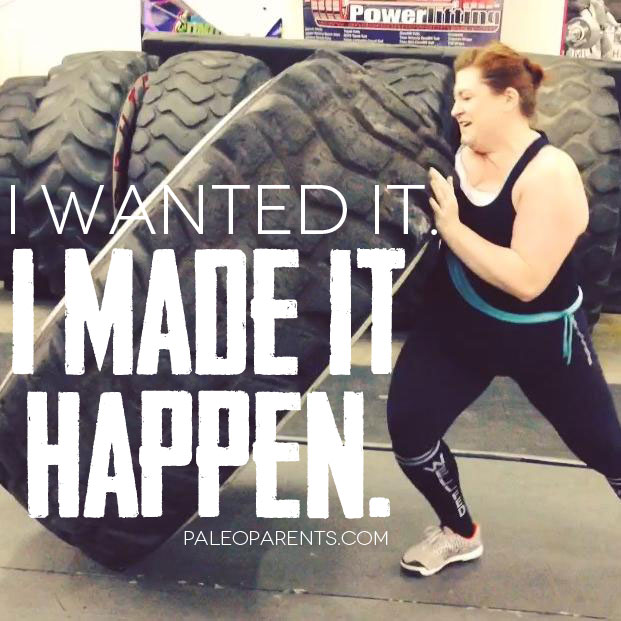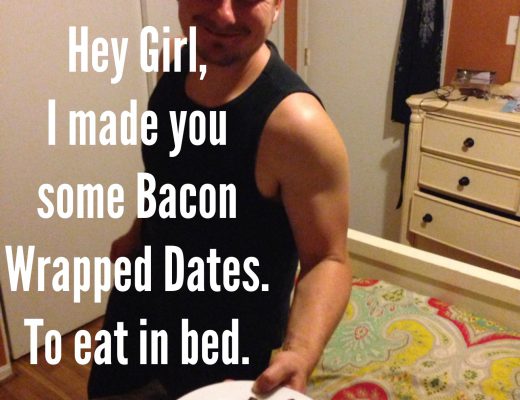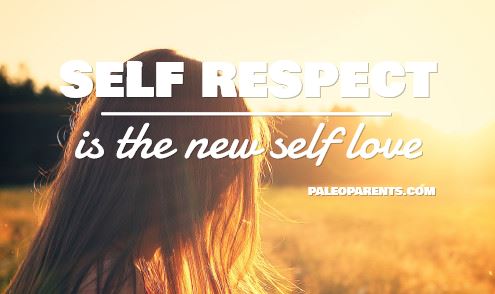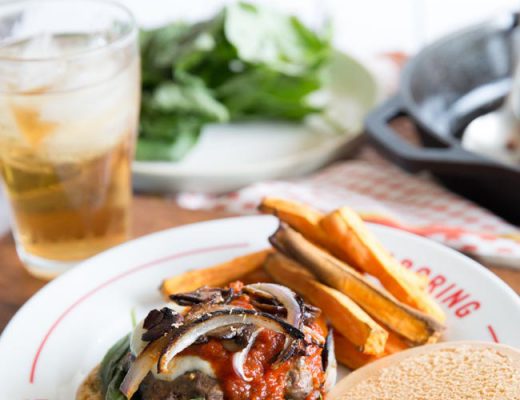Disclaimer: this is a reflection on me and my personal experience with how challenges have impacted my Paleo journey and my personal history of disordered eating. This post is not to imply that Paleo challenges create disordered eating, or that they may not have a place in others’ journeys, but simply a reflection on how challenges could be impacting others who have a history similar to my own. ♥

Yesterday was the last day of the Real Life Paleo book tour, and some of the frequently asked questions are atop my mind. On the tour, as a means to describe why we wrote a book that focuses on phasing into a Paleo lifestyle, I have a line I always deliver that gets a lot of nods (and laughs) from the audience. I think it’s important we open this dialog about how we are all reacting to, behaving with, and thinking about our food choices.
First of all, you can’t just tell your 6 year-old they’re going on a Whole30 and expect them to be thrilled about the opportunity to give up nearly all the foods they’ve become accustomed to eating. But more than that, we hear through the blog, from a myriad of different types of people, that they begin with – and love – a Paleo challenge. Then the day after it ends they fall face first into a pizza buffet. Weeks later when they’re at the gluten-free bakery for the 3rd time that week, they think to themselves, “I need to do another Paleo challenge.” And so the cycle goes, much like a typical yo-yo dieters roller coaster.
After years following Paleo ourselves and talking with so many of you, that’s why we wrote Real Life Paleo. It is the answer to that negative cycle, an approachable, sustainable plan that can set people up for a lifetime of improved health and wellness.
Some Background
It was 2010 when I happened upon the word “Paleo” in a Google search for “dairy-free ice cream.” As a crunchy-granola, cloth-diapering, breastfeeding mom I was giving up dairy for the 3rd time in 5 years because I had finally learned that my own lactose intolerance was being passed through my breastmilk to my newborn baby. It took 3 babies, but I finally wised up to the fact that food was the cause of my first two children’s discomfort and that with the 3rd I wanted to avoid colic, acid reflux and diaper rash all together.
Perhaps it was because I was in the right state of mind, perhaps it was the hormones, perhaps it was because I knew what Paleolithic meant, and enjoyed my Anthropology course in college; but no matter what the reason, I decided I wanted to find out what the heck this strange word meant.

Of course today it’s hard to imagine the word being so foreign, given its popularity (top dietary searches for both 2013 and 2014, surpassing vegan and vegetarianism for the first time evah). But, at the time, I was a morbidly obese woman who’d had a physically demanding and difficult pregnancy. I was exhausted, unhealthy, and desperate for enough energy to sit at the dinner table for a family meal after a day of sitting at a desk in the office, instead of plopping onto a piece of soft furniture the minute I got home. I wanted, more than anything, to play with my children in the yard. I remember watching the boys search for eggs during an Easter egg hunt and wishing I was healthy enough to follow after them and watch it happen, instead of watching from a chair on the deck.
After a lifetime of starvation diets, such as Weight Watchers, paired with disordered eating of bulimia as a teen, followed by continued binging without the purging into my adult years, reading The Paleo Diet blew my mind. All of the symptoms and health conditions I had could all be attributed to the described “Syndrome X” or “metabolic derangement”, neither of which were terms I’d ever heard before. Hours into reading I was shouting from the sofa, where I was nursing our days-old newborn, “YOU HAVE GOT TO READ THIS, I WANT TO DO IT!”
I wanted it. I made it happen.
And within weeks I had manifested the change I’d wanted to see in myself. No gimmicks, no challenges, no perfection, nothing like what Paleo has today – because those things didn’t exist back then. It was simply me, my desire, my willpower, and my ability to execute my dream.

The more my health improved, the more my desire to continue grew. Most people have heard the story by now, that as my severe sleep apnea and heart burn disappeared, as my energy skyrocketed, as my usual post-partum depression never came, and as I was constantly saying how great I felt – we decided the entire family could stand to join me. It was a bit harder to explain to my 5 year old, so we introduced a gradual change for the family. We started making paleo-friendly replacements of food they were used to and put more vegetables on the dinner table instead of pasta, bread, and rice.
And like my own health improvements, the boys all had remarkable changes. My oldest no longer needed a daily-inhaler, which was huge for him to be able to play on the playground without getting sick. My middle boy had a skin condition resolve itself that had bothered him for nearly 18 months (and a doctor had said he needed steroids for). Both boys had behavioral improvements that to this day we are still able to directly link to the foods they consume. And that newborn… never got colic, acid reflux, or nasty painful stools like the other boys. Of course, the 200lbs Matt and I lost was also great motivation.
How It Becomes Disordered
What none of us did for this fantastic success story we’ve now shared hundreds of times within the community was to go on a “Paleo challenge”. I know for a lot of people challenges are their way into the Paleo world, and I think that’s legitimately fantastic. Many people find Paleo because a friend asks them to do a Whole30, or their daughter says “Let’s do a 21 Day Sugar Detox together”, or their CrossFit box hosts a LuRong or Whole Life Challenge. I get it. Over the last nearly five years on this Paleo journey I’ve done them all, most multiple times. But it wasn’t until after I was well into my Paleo journey that these programs came into existence, and once I heard about them, I began doing them nearly non-stop.
You know why I’ve done them all? Because to me, I was using it as yet another mechanism for disordered eating.
For a binge-eater, an emotional-eater, an orthorexic, or any disordered eater there’s an easy bridge and justification that can be made for the fact that when you’re on a challenge you will eat that way for the challenge. It’s easier, you have rules that you yourself have agreed to. So you follow the rules, until it’s over. And then you make all the treats you pinned on Pinterest over those 21 days the first week off of the Challenge, because you can. Perhaps you even justify to yourself that you were so good on your Challenge and it’s a reward and totally fine. Or worse, maybe you’re plagued with guilt because you made a mistake which leads to an emotional eating bender. Weeks later you realize you’re eating your 4th gluten-free sandwich of the week with those amazing cookies you made a triple batch of, and you say to yourself, “I really need to do another detox, I’ll start one at the beginning of next month.” And then you “make the most” of the time leading up to the Challenge by taking advantage of eating things you can’t during it.
And then you’re Paleo for 21 or 30 days again, before you fall off the wagon and start the cycle over again several times throughout the year.

Trust me, I know. I’ve been there. And for many, an annual reset or something you participate in as a community can be a great thing; but if you’re participating in more than 3 Paleo Challenges a year I challenge you to question whether you are using them to justify disordered eating.
When I was at my lowest weight on Paleo, for my 30th birthday because I was desperate for the scale to show me a certain number, I was using Intermittent Fasts as my “purge” with bulimic behavior. It’s taken me years to realize that’s what I was doing, but I’d tell myself I wouldn’t eat for 14 hours, then binge with multiple LaraBars and bacon and fried eggs and then not eat again because I was overly full and filled with guilt.
And then my hair started falling out. And my nails were brittle. I was severely nutrient-deficient again, just as I had been before I started Paleo. And I got sick with an autoimmune flair and adrenal fatigue because my gallbladder-less body didn’t even have enough bile stored to properly digest the one meal I was giving it, not that I was focusing on getting in a variety of nutrient-dense anti-inflammatory foods in that meal either (which is now what I understand Paleo to really be about).
Paleo Challenges aren’t a sustainable lifestyle.
The originators of these plans and challenges and detoxes have said themselves they don’t want people to live their life under these “perfect” mentalities for their daily-lives (see Whole9’s take here and Balanced Bites discuss hers here).
The last year of my life has been the first year I have been legitimately dedicated to my health and wellness, not my weight. I focus on nutrient density, moving my body, and eating low-inflammatory foods that make me feel good. I actively try not to stress out about food. And that’s not easy.
I am fat. And I’m not trying to lose weight. And that’s not easy.
So perhaps my motives are different than yours. But my motives are what drive me – not a warped idea of what I should or shouldn’t look like. I want to be healthy. I want to have energy. I want to play with my kids. My motives remain true to what they were when I originally embarked upon my Paleo journey. I wanted to lose 50lbs, or the absolute dream of 20% of my body weight because my doctor said people who lose 20% of their body weight and keep it off statistically have good health into old age (incidentally I lost over 100lbs and have maintained that 30% loss for years). A lifetime of yo-yoing on and off Paleo challenges aren’t going to keep me strong, improve my blood work, give me sustainable energy and push me to be a healthy 100 years old. Eating nutrient-dense foods, learning to relax, moving my body, getting quality sleep and learning to have patience will. Those are my goals, not being a super model.

Stopping the Disordered Cycle
When I realized earlier this year that what I wanted, more than anything, was to be strong and use my body for good – rather than feeling like it was a burden (as I’d felt my whole life), it really changed a lot of things for me. My mentality switched. I stopped feeling guilt and shame for not looking like a picturesque health activist or Shape Magazine model, and started appreciating my body for what it can DO rather than what it looks like. I created life – thrice – with this body. And now, despite never being athletic in my entire life I can move over 500lbs across 60 feet in mere seconds.
What I had no idea would happen, as I feared the judgement that would come along with “giving up” on losing weight, was how supportive and encouraging everyone would be about my open decision to focus on something other than weight loss! Going on the tour was a huge reminder for me, from meeting all the wonderful people who acknowledged that decision and how it influenced and inspired them to do the same. I LOVE meeting women who tell me they are moving their bodies, lifting heavy things, or inspired to focus on health (instead of their scale) because of something I’ve said or done.
It all started being easier for me when I began thinking more about what I really wanted, and what my goals were, to make my own choices and decisions about food, sleep, alcohol, sugar, and all the factors that lead me to good health when I originally started this Paleo journey in 2010. No challenge or mind game necessary – just me and the ultimate desire to be the healthiest version of me – both mentally and physically. If you too are wanting to take this journey, and get off the roller coaster, here’s what I recommend:
- Make attainable, sustainable goals for yourself. Not everything, all the time. Not perfection. Not even everything all at once. Tell yourself you’ll drink more water and go to bed earlier if that’s what you can do. Then when you’re ready to take on more, do so. We happen to think Real Life Paleo can help you do just that, but by all means customizing your own plan is essential to long-term success. And with each success you have, the better you’ll feel about yourself to take on more. I know that if I set 50 goals for myself and do 49, I will feel like a failure for the 1 thing I missed. Try to stay positive, this will help you do it!
- Don’t let perfectionism be the enemy of the good. In 2012 I posted a picture of our family at 5 Guys (eating bunless burgers) and the interwebz went bananas. We received a blasting of comments from the ‘paleo police’ who condemned our behavior for promoting agents of neolithic disease and shamed us for being bad leaders in the movement (I wish I was kidding). I remember still being out and about town, tears in my eyes as I walked with a toddler on my hip, another kid holding my hand, and having my phone blowing up with notifications of our bad parenting and ineptitude. I remember feeling really overwhelmed with how to handle it. And then Robb Wolf himself commented on our Facebook page to those trolls with the phrase, “Don’t let perfectionism be the enemy of the good” and it’s been my motto ever since. Stress is just as much medically researched to be a cause for chronic health conditions as diet – manage your stress by learning to relax! Know where your own line is, and respect yourself enough not to cross it, but if you have a glass of red wine at dinner when you’d intended to stick with sparkling water – the world will not end. I promise. Shaming others to feel better about your own behavior isn’t a way to win over the world for this lifestyle, either.
- Plan ahead: know yourself and your triggers. Alright, here’s the thing. As much as I focus on telling myself I am choosing not to eat something and using all the tips and tricks in the Self Respect post… I’m still tempted – we all are! So, plan ahead. Keep your favorite dark chocolate in your purse, or whatever your emergency food is when someone’s being a cake-pusher. Know what restaurants are in your area for when you’re feeling like the only alternative to McDonald’s is your arm – if you can find a Chipotle maybe you’ll avoid the really junky fast food. For us as a family this means snacks in our glove box, my “Mary Poppins” purse full of protein bars (we love RxBars, AMRAP, Exo, and EPIC bars), and treats stashed in the boys’ classroom, lunchboxes or anywhere else we can so they don’t feel tempted or left out when a class mate has a birthday or the teacher uses skittles for a match equation (side note: when did that become a thing?!). If I’m able to go on a book tour and stick to my guns (with a calculated decision on Jeni’s ice cream, which I do NOT regret), then you can too!
I hope this can help and inspire those of you who struggled, like I did, with the recurring cycle of Paleo Challenges with the mindset of disordered eating. Be honest with yourself. Think about what and why you are choosing to do them, especially if it’s more than once or twice a year. Maybe it’s time to challenge yourself to just go Paleo for you.




